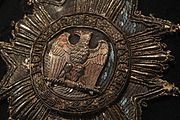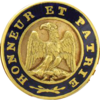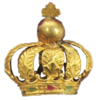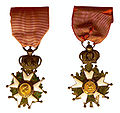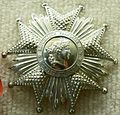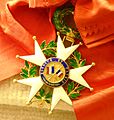|
Legion of Honour
The National Order of the Legion of Honour (French: Ordre national de la Légion d'honneur [ɔʁdʁ nɑsjɔnal də la leʒjɔ̃ dɔnœʁ] ⓘ), formerly the Imperial Order of the Legion of Honour (Ordre impérial de la Légion d'honneur), is the highest French order of merit, both military and civil, and currently comprises five classes. Established in 1802 by Napoleon Bonaparte, it has been retained (with occasional slight alterations) by all later French governments and regimes. The order's motto is Honneur et Patrie ("Honour and Fatherland"); its seat is the Palais de la Légion d'Honneur next to the Musée d'Orsay, on the left bank of the Seine in Paris.[a] Since 1 February 2023, the Order's grand chancellor has been retired General François Lecointre, who succeeded fellow retired General Benoît Puga in office. The order is divided into five degrees of increasing distinction: Chevalier (Knight), Officier (Officer), Commandeur (Commander), Grand officier (Grand Officer) and Grand-croix (Grand Cross). History
ConsulateDuring the French Revolution, all of the French orders of chivalry were abolished and replaced with weapons of honour. It was the wish of Napoleon Bonaparte, the First Consul, to create a reward to commend civilians and soldiers. From this wish was instituted a Légion d'honneur,[2] a body of men that was not an order of chivalry, for Napoleon believed that France wanted a recognition of merit rather than a new system of nobility. However, the Légion d'honneur did use the organization of the old French orders of chivalry, for example, the Ordre de Saint-Louis. The insignia of the Légion d'honneur bear a resemblance to those of the Ordre de Saint-Louis, which also used a red ribbon.[3] Napoleon originally created this award to ensure political loyalty. The organization would be used as a façade to give political favours, gifts, and concessions.[4] The Légion d'honneur was loosely patterned after a Roman legion, with legionaries, officers, commanders, regional "cohorts" and a grand council. The highest rank was not a Grand Cross but a Grand aigle (Grand Eagle), a rank that wore the insignia common to a Grand Cross. The members were paid, the highest of them extremely generously:
Napoleon famously declared, "You call these baubles, well, it is with baubles that men are led... Do you think that you would be able to make men fight by reasoning? Never. That is good only for the scholar in his study. The soldier needs glory, distinctions, rewards."[5] This has been often quoted as "It is with such baubles that men are led." Napoleon was also occasionally noted after a battle to ask who the bravest man in a regiment was, and upon the regiment declaring the individual, the Emperor would take the Legion d'Honneur from his own coat and pin it on the chest of the man.[6] The order was the first modern order of merit. Under the monarchy, such orders were often limited to Roman Catholics, all knights had to be noblemen, and military decorations were restricted to officers.[citation needed] The Légion d'honneur, however, was open to men of all ranks and professions; only merit or bravery counted. The new legionnaire had to be sworn into the Légion d'honneur. All previous orders were Christian, or shared a clear Christian background, whereas the Légion d'honneur is a secular institution. The badge of the Légion d'honneur has five arms.
First EmpireIn a decree issued on the 10 Pluviôse XIII (30 January 1805), a grand decoration was instituted. This decoration, a cross on a large sash and a silver star with an eagle, symbol of the Napoleonic Empire, became known as the Grand aigle (Grand Eagle), and later in 1814 as the Grand cordon (big sash, literally "big ribbon"). After Napoleon crowned himself Emperor of the French in 1804 and established the Napoleonic nobility in 1808, award of the Légion d'honneur gave right to the title of "Knight of the Empire" (Chevalier de l'Empire). The title was made hereditary after three generations of grantees. Napoleon had dispensed 15 golden collars of the Légion d'honneur among his family and his senior ministers. This collar was abolished in 1815. Although research is made difficult by the loss of the archives, it is rumoured that three women who fought with the army were decorated with the order: Virginie Ghesquière, Marie-Jeanne Schelling and a nun, Sister Anne Biget.[b] The Légion d'honneur was prominent and visible in the French Empire. The Emperor always wore it, and the fashion of the time allowed for decorations to be worn most of the time. The king of Sweden therefore declined the order; it was too common in his eyes. Napoleon's own decorations were captured by the Prussians and were displayed in the Zeughaus (armoury) in Berlin until 1945. Today, they are in Moscow. The Legion of Honour under the Empire
Restoration of the Bourbon King of France in 1814Louis XVIII changed the appearance of the order, but it was not abolished. To have done so would have angered the 35,000 to 38,000 members. The images of Napoleon and his eagle were removed and replaced by the image of King Henry IV, the popular first king of the Bourbon line. Three Bourbon fleurs-de-lys replaced the eagle on the reverse of the order. A king's crown replaced the imperial crown. In 1816, the grand cordons were renamed grand crosses and the legionnaires became knights. The king decreed that the commandants were now commanders. The Légion d'honneur became the second-ranking order of knighthood of the French monarchy, after the Order of the Holy Spirit. July Monarchy  Following the overthrow of the Bourbons in favour of King Louis Philippe I of the House of Orléans, the Bourbon monarchy's orders were once again abolished and the Légion d'honneur was restored in 1830 as the paramount decoration of the French nation. The insignia were drastically altered; the cross now displayed tricolour flags. In 1847, there were 47,000 members. Second RepublicYet another revolution in Paris (in 1848) brought a new republic (the second) and a new design to the Légion d'honneur. A nephew of the founder, Louis-Napoléon Bonaparte, was elected president and he restored the image of his uncle on the crosses of the order. In 1852, the first recorded woman, Angélique Duchemin, an old revolutionary of the 1789 uprising against the absolute monarchy, was admitted into the order. On 2 December 1851, President Louis-Napoléon Bonaparte staged a coup d'état with the help of the armed forces. He made himself Emperor of the French exactly one year later on 2 December 1852, after a successful plebiscite. Second EmpireAn Imperial crown was added. During Napoleon III's reign, the first American was admitted: Thomas Wiltberger Evans, dentist of Napoleon III. Third Republic In 1870, the defeat of the French Imperial Army in the Franco-Prussian War brought the end of the Empire and the creation of the Third Republic (1871–1940). As France changed, the Légion d'honneur changed as well. The crown was replaced by a laurel and oak wreath. In 1871, during the Paris Commune uprising, the Hôtel de Salm, headquarters of the Légion d'honneur, was burned to the ground in fierce street combats; the archives of the order were lost. In the second term of President Jules Grévy, which started in 1885, newspaper journalists brought to light the trafficking of Grévy's son-in-law, Daniel Wilson, in the awarding of decorations of the Légion d'honneur. Grévy was not accused of personal participation in this scandal, but he was slow to accept his indirect political responsibility, which caused his eventual resignation on 2 December 1887. During World War I, some 55,000 decorations were conferred, 20,000 of which went to foreigners. The large number of decorations resulted from the new posthumous awards authorised in 1918. Traditionally, membership in the Légion d'honneur could not be awarded posthumously. Fourth and Fifth RepublicsThe establishment of the Fourth Republic in 1946 brought about the latest change in the design of the Legion of Honour. The date "1870" on the obverse was replaced by a single star. No changes were made after the establishment of the Fifth Republic in 1958.  Organisation
Legal status and leadershipThe Legion of Honour is a national order of France, meaning a public incorporated body. The Legion is regulated by a civil law code, the "Code of the Legion of Honour and of the Military Medal". While the President of the French Republic is the Grand Master of the order, day-to-day running is entrusted to the Grand Chancery (Grande Chancellerie de la Légion d'honneur). Grand Master Since the establishment of the Legion, the Grand Master of the order has always been the Emperor, King or President of France. President Emmanuel Macron therefore became the Grand Master of the Legion on 14 May 2017.[7] The Grand Master appoints all other members of the order, on the advice of the French government. The Grand Master's insignia is the Grand Collar of the Legion. The President of the Republic, as Grand Master of the order, receives the Collar as part of his investiture, but the Grand Masters have not worn the Collar since Valéry Giscard d'Estaing.[8] The Grand ChanceryThe Grand Chancery is headed by the Grand Chancellor (grand chancelier), usually a retired general, as well as the Secretary-General (secrétaire général), a civilian administrator.
The Grand Chancery also regulates the National Order of Merit and the médaille militaire (Military Medal). There are several structures funded by and operated under the authority of the Grand Chancery, like the Legion of Honour Schools (Maisons d'éducation de la Légion d'honneur) and the Legion of Honour Museum (Musée de la Légion d'honneur). The Legion of Honour Schools are élite boarding schools in Saint-Denis and Camp des Loges in the forest of Saint-Germain-en-Laye. Study there is restricted to daughters, granddaughters, and great-granddaughters of members of the order, the médaille militaire or the ordre national du Mérite.[10] MembershipThere are five classes in the Legion of Honour:
The "eminent merits" required to be awarded the order require the flawless performance of one's trade as well as doing more than ordinarily expected, such as being creative, zealous and contributing to the growth and well-being of others. The order has a maximum quota of 75 Grand Cross, 250 Grand Officers, 1,250 Commanders, 10,000 Officers, and 113,425 (ordinary) Knights. As of 2010,[update] the actual membership was 67 Grand Cross, 314 Grand Officers, 3,009 Commanders, 17,032 Officers and 74,384 Knights. Appointments of veterans of World War II, French military personnel involved in the North African Campaign and other foreign French military operations, as well as wounded soldiers, are made independently of the quota. Members convicted of a felony (crime in French) are automatically dismissed from the order. Members convicted of a misdemeanour (délit in French) can be dismissed as well, although this is not automatic. Wearing the decoration of the Légion d'honneur without having the right to do so is a serious offence. Wearing the ribbon or rosette of a foreign order is prohibited if that ribbon is mainly red, like the ribbon of the Legion of Honour. French military personnel in uniform must salute other military members in uniform wearing the medal, whatever the Légion d'honneur rank and the military rank of the bearer. This is not mandatory with the ribbon. In practice, however, this is rarely done. There is not a single, complete list of all the members of the Legion in chronological order. The number is estimated at one million, including about 2,900 Knights Grand Cross.[11] French nationalsFrench nationals, men and women, can be received into the Légion, for "eminent merit" (mérites éminents) in military or civil life. In practice, in current usage, the order is conferred on entrepreneurs, high-level civil servants, scientists, artists, including famous actors and actresses, sport champions,[c] and others with connections in the executive. Members of the French Parliament cannot receive the order, except for valour in war,[12] and ministers are not allowed to nominate their accountants. Until 2008, French nationals could only enter the Legion of Honour at the class of Chevalier (Knight). To be promoted to a higher class, one had to perform new eminent services in the interest of France and a set number of years had to pass between appointment and promotion. This was however amended in 2008 when entry became possible at Officer, Commander and Grand Officer levels, as a recognition of "extraordinary careers" (carrières hors du commun). In 2009, Simone Veil became the first person to enter the Order at Grand Officer level.[13] Veil was a member of the Académie française, a former Health Minister and President of the European Parliament, as well as an Auschwitz survivor. She was promoted to Grand Cross in 2012. Every year at least five recipients decline the award. Even if they refuse to accept it, they are still included in the order's official membership.[8] The composers Maurice Ravel and Charles Koechlin, for example, declined the award when it was offered to them.[14][15] Non-French recipientsWhile membership in the Légion is technically restricted to French nationals,[16] foreign nationals who have served France or the ideals it upholds[17] may receive the honour.[18] Foreign nationals who live in France are subject to the same requirements as the French. Foreign nationals who live abroad may be awarded a distinction of any rank or dignity in the Légion. Foreign heads of state and their spouses or consorts of monarchs are made Grand Cross as a courtesy. American and British veterans who served in either World War on French soil,[19] or during the 1944 campaigns to liberate France,[20][21] may be eligible for appointment as Chevalier of the Legion of Honour, provided they were still living when the honour was approved. Collective awardsCollective appointments can be made to cities, institutions or companies. A total of 64 settlements in France have been decorated, as well as six foreign cities: Liège in 1914,[22] Belgrade in 1920,[23] Luxembourg City in 1957, Volgograd (the World War II 'Stalingrad') in 1984,[24] Algiers in 2004, and London in 2020.[25][26] French towns display the decoration in their municipal coat of arms. Organisations to receive the honour include the French Red Cross (Croix-Rouge Française), the Abbaye de Nôtre-Dame des Dombes (Abbey of Notre-Dame des Dombes), the French National Railway Company (SNCF, Société Nationale des Chemins de fer Français), the Préfecture de Police de la Ville de Paris (Prefecture of Police of Paris), and various Grandes Écoles (National (Elite) Colleges) and other educational establishments. Military awards The military distinctions (Légion d'honneur à titre militaire) are awarded for bravery (actions de guerre) or for service.
French service-membersFor active-duty commissioned officers, the Legion of Honour award for service is achieved after 20 years of meritorious service, having been awarded the rank of Chevalier of the Ordre National du Mérite. Bravery awards lessen the time needed for the award—in fact decorated servicemen become directly chevaliers of the Légion d'Honneur, skipping the Ordre du Mérite. NCOs almost never achieve that award, except for the most heavily decorated service members. Collective military awardsCollective appointments can be made to military units. In the case of a military unit, its flag is decorated with the insignia of a knight, which is a different award from the fourragère. Twenty-one schools, mainly schools providing reserve officers during the World Wars, were awarded the Légion d'Honneur. Foreign military units can be decorated with the order, such as the U.S. Military Academy. The Flag or Standard of the following units was decorated with the Cross of a Knight of the Legion of Honour:[d]
Classes and insignia The order has had five levels since the reign of King Louis XVIII, who restored the order in 1815. Since the reform, the following distinctions have existed:
Due to the order's long history, and the remarkable fact that it has been retained by all subsequent governments and regimes since the First Empire, the order's design has undergone many changes. Although the basic shape and structure of the insignia has remained generally the same, the hanging device changed back and forth and France itself swung back and forth between republic and monarchy. The central disc in the centre has also changed to reflect the political system and leadership of France at the time. As each new regime came along the design was altered to become politically correct for the time, sometimes even changed multiple times during one historical era.  The badge of the Légion is shaped as a five-armed "Maltese Asterisk", using five distinctive "arrowhead" shaped arms inspired by the Maltese Cross. The badge is rendered in gilt (in silver for chevalier) enameled white, with an enameled laurel and oak wreath between the arms. The obverse central disc is in gilt, featuring the head of Marianne, surrounded by the legend République Française on a blue enamel ring. The reverse central disc is also in gilt, with a set of crossed tricolores, surrounded by the Légion's motto Honneur et Patrie ('Honour and Fatherland') and its foundation date on a blue enamel ring. The badge is suspended by an enameled laurel and oak wreath. The star (or plaque) is worn by the Grand Cross (in gilt on the left chest) and the Grand Officer (in silver on the right chest) respectively; it is similar to the badge, but without enamel, and with the wreath replaced by a cluster of rays in between each arm. The central disc features the head of Marianne, surrounded by the legend République Française ('French Republic') and the motto Honneur et Patrie.[27] The ribbon for the medal is plain red. The badge or star is not usually worn, except at the time of the decoration ceremony or on a dress uniform or formal wear. Instead, one normally wears the ribbon or rosette on their suit. For less formal occasions, recipients wear a simple stripe of thread sewn onto the lapel (red for chevaliers and officiers, silver for commandeurs). Except when wearing a dark suit with a lapel, women instead typically wear a small lapel pin called a barrette. Recipients purchase the special thread and barrettes at a store in Paris near the Palais-Royal.[28]
GallerySee also: Category:Legion of Honour in heraldry
See also
References and notesNotes
Citations
External linksWikimedia Commons has media related to Legion of Honour.
|
|||||||||||||||||||||||||||||||||||||||||||||||||||||||||||||||||||||||||||||||||||||||||||||||||||||||||||||||||||||||||








![As Emperor, Napoleon always wore the Cross and Grand Eagle of the Legion of Honour.[citation needed]](http://upload.wikimedia.org/wikipedia/commons/thumb/5/53/Napoleon_Paul_Delaroche.jpg/136px-Napoleon_Paul_Delaroche.jpg)
